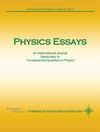玻尔的原子模型和概率现实
IF 0.5
Q4 PHYSICS, MULTIDISCIPLINARY
引用次数: 0
摘要
在玻尔原子吸收和发射电磁辐射(即光子)模型的完整振荡过程中,对电子跃迁(即原子电子的非瞬时跃迁)而不是量子跃迁(即瞬时跃迁)应用速度瞬时性特性进行分析,发现了作为发射电磁辐射(即光子)不连续性守恒的不连续性。原子电子(即电荷)的振荡频率和原子电子(即电荷)在吸收和发射过程(玻尔原子模型)的完整振荡过程中的跃迁感应磁场,作为发射电磁辐射(即光子)的振荡电场和磁场的频率是守恒的。原子吸收和发射过程(玻尔原子模型)的守恒频率和不连续性(基于速度瞬时性和非瞬时的电子跃迁)导致无需使用概率即可预测普朗克常数(即量子作用)的必要性。普朗克声称,如果他推导辐射定律的方法建立在一个物理概念上,那么对现实的解释就必须改变。普朗克认为爱因斯坦是第一个在量子领域取得进展的人,他在不知情的情况下引入了量子化的二维非连续几何,这是物理学中用于预测的五实相表的基础之一。利用五实相表重新定义了局域性,并揭开了纠缠的神秘面纱。本文章由计算机程序翻译,如有差异,请以英文原文为准。
Bohr’s atomic model and the probabilistic reality
An analysis of applying the property of speed instantaneity to electronic transitions (i.e., transitions of the atomic electron that are not instantaneous), instead of quantum jumps (i.e., instantaneous transitions), during a complete oscillation for the process of Bohr’s model
of the atom absorbing and emitting electromagnetic radiation (i.e., photon) reveals a discontinuity that is conserved as an emitted electromagnetic radiation (i.e., photon) discontinuity. The frequency of the oscillations of the atomic electron (i.e., electric charge) and induced magnetic
field for the transitions of the atomic electron (i.e., electric charge) during the complete oscillation for the absorption and emission process (of Bohr’s atomic model) is conserved as the frequency of the oscillating electric and magnetic fields of the emitted electromagnetic radiation
(i.e., photon). The conserved frequency and discontinuity (based on speed instantaneity and electronic transitions that are not instantaneous) of the atomic absorption and emission process (of Bohr’s atomic model) lead to predicting the need for Planck’s constant (i.e., quantum
of action) without the use of probability. Planck claimed the interpretation of reality must change if his method of deriving the radiation law stood on a physical concept. Einstein, whom Planck credited as the first to make an advancement in the quantum field, unknowingly introduced a quantized
two-dimensional discontinuum geometry that is one of the foundations on which a table of five realities used in physics was developed for making predictions. Using the table of realities, locality is redefined, and entanglement is demystified.
求助全文
通过发布文献求助,成功后即可免费获取论文全文。
去求助
来源期刊

Physics Essays
PHYSICS, MULTIDISCIPLINARY-
自引率
83.30%
发文量
50
审稿时长
6-12 weeks
期刊介绍:
Physics Essays has been established as an international journal dedicated to theoretical and experimental aspects of fundamental problems in Physics and, generally, to the advancement of basic knowledge of Physics. The Journal’s mandate is to publish rigorous and methodological examinations of past, current, and advanced concepts, methods and results in physics research. Physics Essays dedicates itself to the publication of stimulating exploratory, and original papers in a variety of physics disciplines, such as spectroscopy, quantum mechanics, particle physics, electromagnetic theory, astrophysics, space physics, mathematical methods in physics, plasma physics, philosophical aspects of physics, chemical physics, and relativity.
 求助内容:
求助内容: 应助结果提醒方式:
应助结果提醒方式:


